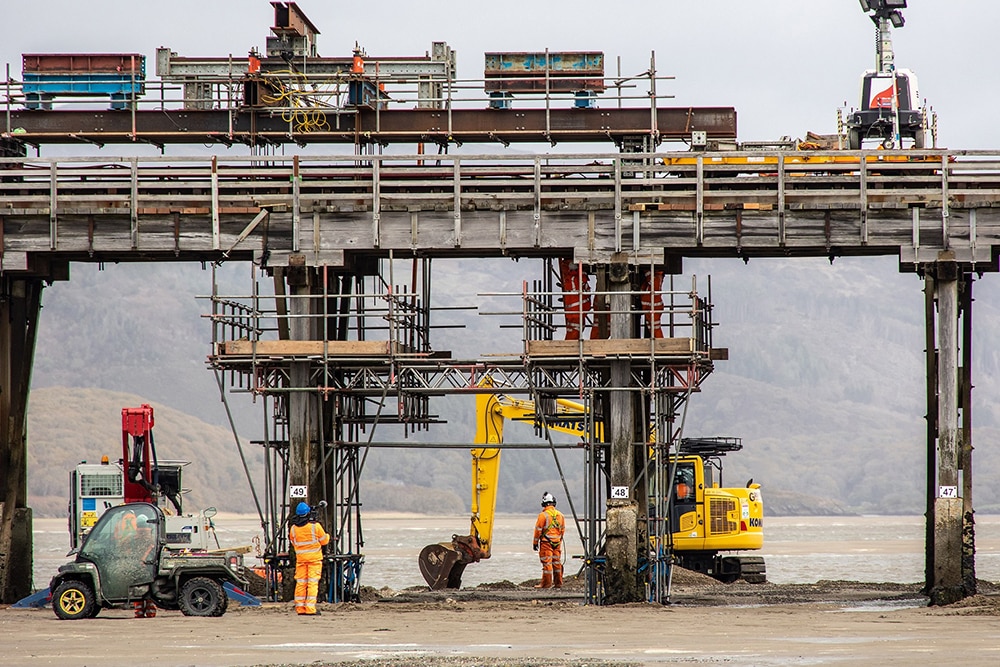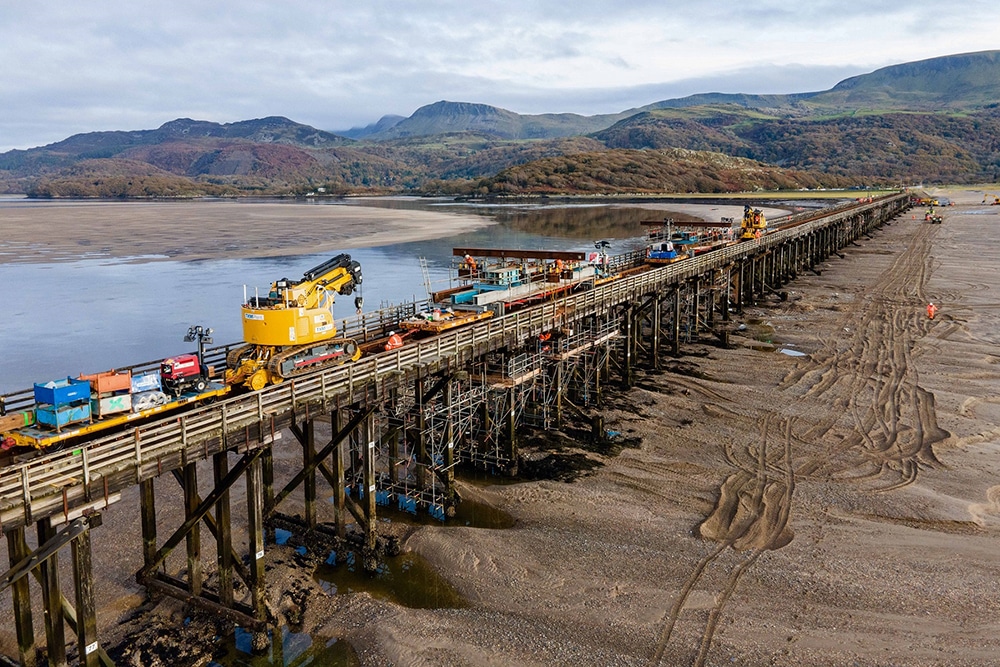Bridges are an integral part of this country’s rail network and their closure, whether due to structural repairs or an accidental bridge strike, can have a real impact on services.
As such, repairing them quickly and efficiently is vital. Here, Colin Campbell, Senior Engineer at temporary works specialist Mabey Hire, explains how jacking solutions were used on the restoration of Barmouth Bridge to keep disruption to a minimum.
“When it comes to maintaining or repairing one of over 30,000 rail bridges, tunnels and viaducts in the UK, it’s important to choose solutions that can ensure the bridge is safe to remain open whilst repairs are carried out, or one that can minimise disruption.
Temporary propping and jacking solutions are just one example, used to provide structural support for everything from building façades to bridges, to even lifting a bridge off its support piers while work is carried out underneath.
In fact, alongside civil engineering contractor Alun Griffiths, Mabey Hire employed an innovative bridge lifting technique, as part of a £25 million Network Rail project to restore the historic Barmouth Bridge in Barmouth, Wales to its former glory. Developed by Mabey Hire and Alun Griffiths, the new bridge lifting technique helps to minimise disruption and save time, contributing to a safer and more efficient construction process.

A Grade II listed timber railway viaduct, Barmouth Bridge spans over the Afon Mawddach estuary in Wales. At over 150 years old, Barmouth Bridge is one of the oldest viaducts of its type still in regular use, carrying trains and pedestrians over the 860-metre distance.
Given both its age and continued exposure to the coastal elements, the bridge was sadly in poor condition, with decay and corrosion having affected many of its timber and metal components. As a result, Network Rail announced a major programme of upgrade and restoration works, which will see the viaduct completely restored in a manner sensitive to both its industrial heritage and listed status, with components to be replaced on a ‘like for like’ basis.
As part of the restoration works, 24 of the viaduct’s crossheads were to be replaced, having become severely corroded. Led by civil engineering contractor Alun Griffiths, the project required the bridge to be lifted off its piers, enabling the damaged crossheads to be individually removed and replaced.
With a substantial scheme of temporary works required to facilitate the bridge lift, we were appointed to design, supply and install the temporary jacking system. The bespoke system featured an innovative bridge lifting technique, previously pioneered on a similar timber viaduct in Gwynedd, Wales.
When working on live infrastructure, such as the country’s rail network, keeping disruption to a minimum and ensuring works are carried out as quickly as possible is essential. Initially developed with Alun Griffiths, Cass Hayward and Network Rail IP Engineering in 2019, our innovative system involves a combination of proprietary steel supports and jacks, which are built remotely and then transported into position.
Once on site, this approach enables work to be carried out on crossheads and support piers without having to strip the track and deck structures, allowing for a safer and more efficient process. There is also the potential for further time savings, as the whole jacking system can be simply moved along the track to the next pier, as opposed to having to dismantle and re-install.
As Barmouth Bridge featured a pedestrian bridge parallel to the rail tracks, we also had to design the lifting frame with a bespoke cantilevered edge, in order to allow for this site constraint. Hangar bars were then dropped through each bridge span with the bridge jacked from the top side, lifting the structure off the piers below and supported underneath. This technique enabled all the main lifting work to be carried out on the top side of the bridge – especially valuable considering that the tidal estuary and lack of a foundation meant access to the underneath of the bridge was difficult.
An additional challenge on the project was the time constraints, with the work taking place during an 18-day closure of the railway. Given this tight window, the decision was made to supply two of our bespoke jacking systems. With our team of steel erectors on site 24/7 to ensure the lifts went smoothly and each jacking system operating from either end of the bridge, before meeting in the middle, we were able to complete the works at a far faster rate.
Our jacking system remained on site for 18 days, while Alun Griffiths carried out the necessary repair and replacement works on the bridge’s crossheads. The restoration programme continues on the Welsh bridge, with work expected to be completed in 2022.
As an award-winning temporary works specialist, we have over 60 years’ experience providing customers large and small with solutions to their propping and jacking requirements.
Whether it’s a light propping job, a bridge lift, a façade retention or anything in-between, our wide and versatile range, combined with our engineering teams’ skills, ensures that we can deliver a tailored solution.”
For more information about Mabey Hire, please visit www.mabeyhire.co.uk

Photo credit: Mabey Hire



































 0113 2082620
0113 2082620 info@railbusinessdaily.com
info@railbusinessdaily.com 15 Mariner Court, Wakefield WF4 3FL
15 Mariner Court, Wakefield WF4 3FL

